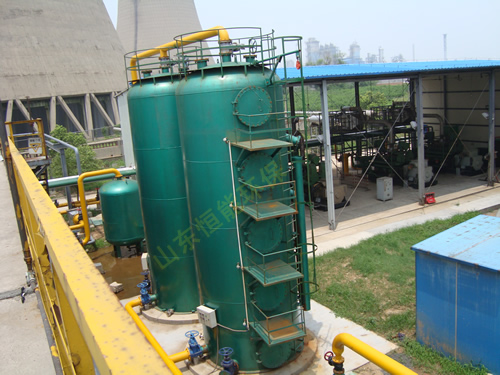欢迎进入山东恒能环保能源设备有限公司
欢迎进入山东恒能环保能源设备有限公司
硫化氢(H2S),一种具有臭鸡蛋气味的有毒恶臭气体,在众多工业活动中均有出现。生物处理被认为是处理这种恶臭气体的最佳方法,主要因其低成本和高安全性。在众多生物反应器中,生物滴滤池(BTF)因其可控的操作参数和易排出的代谢产物而备受关注。然而,生物反应器在运行中常遇到生物量过度积累导致的高压降问题,这不仅增加能源消耗,还会降低反应器性能。传统的生物量控制方法如高速水流冲洗、进气负荷控制、营养元素供给和化学清洗,虽有效但成本较高且可能影响反应器恢复性能。本文的目的是探究pH值变化对脱硫生物反应器微生物群落结构的影响,分析不同pH范围内的反应器性能和压降变化,并提出利用pH控制生物量增长的策略,旨在提高脱硫性能并减少运营成本,以推动脱硫技术的发展和应用。图文摘要BTF系统对H2S的长期去除性能如图1所示。在阶段I,BTF系统在中性偏碱性条件下运行(6.0<pH<9.5)。BTF在该阶段获得的对H2S的最大去除速率(ECmax)为246.5g/(m3·h)(去除率为82.8%);阶段II是弱酸性运行阶段(pH在2.6-5.5)。在该阶段获得的ECmax为142.8 g/(m3·h)(去除率为66.6%)。传质阻力的增加和硫氧化菌(SOB)的活性降低是造成弱酸性时期脱硫性能下降主要原因;阶段III为极酸性运行阶段,在不添加碱性试剂的情况下,循环液的pH逐渐下降到1.0以下。BTF在该阶段获得的ECmax为164.6g/(m3·h)(去除率为65.0%)。极酸性时期的EC和SOB活性低于中性偏碱性时期,但明显高于弱酸性时期。图1 BTF在不同pH时期的长期运行效果
Hydrogen sulfide (H2S), a toxic and foul smelling gas with a foul egg odor, is present in many industrial activities. Biological treatment is considered the best method for treating this odorous gas, mainly due to its low cost and high safety. Among numerous bioreactors, the biological drip filter (BTF) has attracted much attention due to its controllable operating parameters and easy elimination of metabolites. However, bioreactors often encounter high pressure drop problems caused by excessive biomass accumulation during operation, which not only increases energy consumption but also reduces reactor performance. Traditional biomass control methods such as high-speed water flow flushing, intake load control, nutrient supply, and chemical cleaning are effective but costly and may affect reactor recovery performance. The purpose of this article is to explore the impact of pH changes on the microbial community structure of desulfurization bioreactors, analyze reactor performance and pressure drop changes within different pH ranges, and propose strategies for controlling biomass growth using pH, with the aim of improving desulfurization performance and reducing operating costs to promote the development and application of desulfurization technology. The long-term removal performance of the BTF system for H2S is shown in Figure 1. In Stage I, the BTF system operates under neutral to alkaline conditions (6.0<pH<9.5). The maximum removal rate (ECmax) of H2S obtained by BTF in this stage is 246.5g/(m3 · h) (removal rate of 82.8%); Stage II is the weakly acidic operating stage (pH between 2.6-5.5). The ECmax obtained at this stage is 142.8 g/(m3 · h) (removal rate of 66.6%). The increase in mass transfer resistance and the decrease in activity of sulfur oxidizing bacteria (SOBs) are the main reasons for the decline in desulfurization performance during weak acidic periods; Stage III is an extremely acidic operating stage, in which the pH of the circulating solution gradually decreases to below 1.0 without adding alkaline reagents. The ECmax obtained by BTF in this stage is 164.6 g/(m3 · h) (removal rate of 65.0%). The EC and SOB activities during the extremely acidic period are lower than those during the neutral alkaline period, but significantly higher than those during the weakly acidic period. Figure 1 Long term operation effect of BTF at different pH periods
图2显示了过滤床内生物量和压降(ΔP)的变化。生物量和ΔP在碱性运行时期迅速增长。随着pH降低至弱酸性范围内,在没有进行曝气冲洗的前提下,生物量和ΔP开始呈现出降低的趋势。当循环液pH降低至1以下(极酸性时期),生物量和ΔP进一步下降至10-11g/L和99-117Pa/m,并长期维持在该水平。图2 过滤床内生物量和ΔP变化图3显示了各时期生物膜菌群结构变化。在中性偏碱性时期,BTF系统中富集到的微生物主要为耐碱和耐盐的异养菌,如Pseudomonas、Stenotrophomonas、Brevundimonas、Halomonas、Brucella和Evansella。在弱酸性阶段,这一时期的大多数细菌是轻度嗜酸的SOB,如Acidithiobacillus、Metallibacterium、Thiomonas和Acidiphilium等。一些异养细菌如Brucella和Evansella在这一时期未被检测到,因为它们难以适应酸性的环境。在长期极酸性条件下,嗜酸性SOB-?Mycobacterium(79.2%)逐渐占据主导地位,非耐酸的微生物被淘汰。图3 各时期生物膜菌群结构变化
Figure 2 shows the changes in biomass and pressure drop (Δ P) within the filter bed. The biomass and Δ P increase rapidly during alkaline operation. As the pH decreases to the weakly acidic range, biomass and Δ P begin to show a decreasing trend without aeration flushing. When the pH of the circulating solution drops below 1 (during the extremely acidic period), biomass and Δ P further decrease to 10-11g/L and 99-117Pa/m, and remain at these levels for a long time. Figure 2 shows the changes in biomass and Δ P within the filter bed, while Figure 3 illustrates the structural changes in biofilm microbiota at different stages. During the neutral to alkaline period, the microorganisms enriched in the BTF system are mainly alkali and salt tolerant heterotrophic bacteria, such as Pseudomonas, Stenotrophomonas, Brevundimonas, Halomonas, Brucella, and Evansella. In the weakly acidic stage, most bacteria during this period are mildly acidophilic SOBs, such as Acinethiobacillus, Metallibacterium, Thiomonas, and Acidiphilium. Some heterotrophic bacteria such as Brucella and Evansella were not detected during this period because they had difficulty adapting to acidic environments. Under long-term extremely acidic conditions, acidophilic SOB Mycobacterium (79.2%) gradually dominates, and non acid resistant microorganisms are eliminated. Figure 3 Changes in the structure of biofilm microbiota in different periods
小结BTF在碱性、弱酸性和极酸性条件下获得的ECmax分别为246.5、142.8和164.6 g/(m3·h)。中性偏碱下BTF的脱硫性能最佳,这是由于较低的H2S气液传质阻力及较高的硫氧化菌活性。保持此pH范围需消耗大量碱性试剂,这导致反应器的运行成本升高和操作过程变得复杂。在极酸环境中,耐酸的硫氧化菌-Mycobacterium逐渐占据主导(79.2%),且生物膜拥有高硫氧化活性,非耐酸的微生物被淘汰,这维持了系统内生物量的稳定(生物量浓度10-11g/L),避免了反应器的堵塞,降低了生物量控制和pH调整的成本。通过富集高丰度且高活性嗜酸的Mycobacterium,BTF在极酸环境(pH < 1.0)下仍可获得较高的脱硫性能,扩大了生物反应器运行的pH范围。
The ECmax values of BTF obtained under alkaline, weakly acidic, and extremely acidic conditions were 246.5, 142.8, and 164.6 g/(m3 · h), respectively. The desulfurization performance of BTF is optimal under neutral alkaline conditions, due to lower H2S gas-liquid mass transfer resistance and higher sulfur oxidizing bacterial activity. Maintaining this pH range requires a large amount of alkaline reagents, which increases the operating cost of the reactor and makes the operation process more complex. In extremely acidic environments, acid resistant sulfur oxidizing bacteria Mycobacteria gradually dominate (79.2%), and biofilms have high sulfur oxidation activity. Non acid resistant microorganisms are eliminated, which maintains the stability of biomass in the system (biomass concentration 10-11g/L), avoids reactor blockage, and reduces the cost of biomass control and pH adjustment. By enriching high abundance and high activity acidophilic Mycobacterium, BTF can still achieve high desulfurization performance in extremely acidic environments (pH<1.0), expanding the pH range of bioreactor operation.
本文由 生物脱硫 友情奉献.更多有关的知识请点击 https://www.hneee.net/ 真诚的态度.为您提供为全面的服务.更多有关的知识我们将会陆续向大家奉献.敬请期待.
This article is contributed by the friendship of biological desulfurization For more related knowledge, please click https://www.hneee.net/ Sincere attitude To provide you with comprehensive services We will gradually contribute more relevant knowledge to everyone Coming soon.
相关新闻